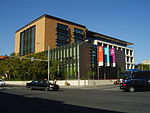Oasis Restaurant

The Oasis on Lake Travis is a restaurant on the western edge of Austin, Texas. The restaurant promotes itself as the "Sunset Capital of Texas" with its terraced views looking West over Lake Travis. The thirty thousand square foot restaurant sits on a bluff 450 feet above the lake and is the largest outdoor restaurant in Texas. The restaurant was first built in 1982 by Houston entrepreneur Beau Theriot, who purchased a 500-acre (2.0 km2) ranch overlooking the lake and converted it into the current multi-use venue.On the morning of June 1, 2005, a lightning strike ignited a fire which consumed much of the property. Parts of the facility that were not damaged were reopened within weeks, while other parts were rebuilt.
Excerpt from the Wikipedia article Oasis Restaurant (License: CC BY-SA 3.0, Authors, Images).Oasis Restaurant
Comanche Trail,
Geographical coordinates (GPS) Address Nearby Places Show on map
Geographical coordinates (GPS)
| Latitude | Longitude |
|---|---|
| N 30.406571 ° | E -97.87521 ° |
Address
Comanche Trail 6612
78732
Texas, United States
Open on Google Maps







